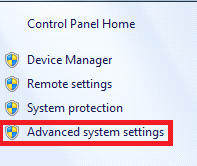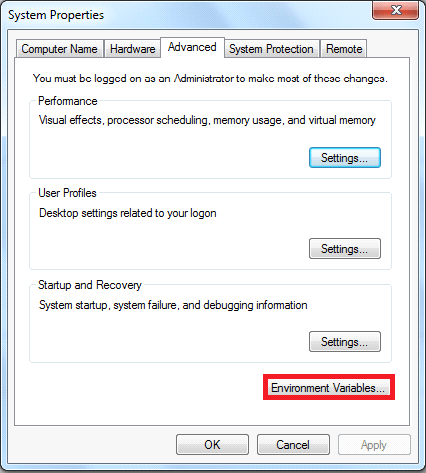How To Add Junit To The Class Path
adjacent → ← prev
How to Set CLASSPATH in Java
CLASSPATH: CLASSPATH is an environment variable which is used by Awarding ClassLoader to locate and load the .class files. The CLASSPATH defines the path, to observe third-party and user-divers classes that are not extensions or part of Coffee platform. Include all the directories which comprise .class files and JAR files when setting the CLASSPATH.
You lot demand to set the CLASSPATH if:
- Y'all need to load a class that is not present in the current directory or any sub-directories.
- Y'all need to load a form that is non in a location specified by the extensions mechanism.
The CLASSPATH depends on what you are setting the CLASSPATH. The CLASSPATH has a directory proper name or file name at the cease. The post-obit points draw what should be the end of the CLASSPATH.
- If a JAR or null, the file contains class files, the CLASSPATH end with the name of the zip or JAR file.
- If class files placed in an unnamed package, the CLASSPATH ends with the directory that contains the course files.
- If course files placed in a named package, the CLASSPATH ends with the directory that contains the root parcel in the total package name, that is the first packet in the full package name.
The default value of CLASSPATH is a dot (.). Information technology means the only current directory searched. The default value of CLASSPATH overrides when yous set the CLASSPATH variable or using the -classpath command (for short -cp). Put a dot (.) in the new setting if you want to include the electric current directory in the search path.
If CLASSPATH finds a class file which is present in the current directory, then it will load the course and use it, irrespective of the aforementioned name class presents in another directory which is also included in the CLASSPATH.
If you want to set multiple classpaths, then you need to separate each CLASSPATH by a semicolon (;).
The third-party applications (MySQL and Oracle) that apply the JVM can modify the CLASSPATH environment variable to include the libraries they utilise. The classes can be stored in directories or archives files. The classes of the Java platform are stored in rt.jar.
There are two ways to ways to set CLASSPATH: through Command Prompt or by setting Environment Variable.
Allow's see how to ready CLASSPATH of MySQL database:
Step 1: Click on the Windows push and choose Control Panel. Select System.

Step two: Click on Avant-garde Arrangement Settings.

Pace 3: A dialog box will open. Click on Environment Variables.

Stride 4: If the CLASSPATH already exists in System Variables, click on the Edit push button then put a semicolon (;) at the terminate. Paste the Path of MySQL-Connector Java.jar file.
If the CLASSPATH doesn't be in System Variables, so click on the New push button and blazon Variable name as CLASSPATH and Variable value every bit C:\Program Files\Coffee\jre1.8\MySQL-Connector Java.jar;.;
Remember: Put ;.; at the end of the CLASSPATH.

Difference between PATH and CLASSPATH
| PATH | CLASSPATH |
|---|---|
| PATH is an environment variable. | CLASSPATH is besides an environment variable. |
| It is used past the operating system to find the executable files (.exe). | It is used by Application ClassLoader to locate the .class file. |
| Y'all are required to include the directory which contains .exe files. | You are required to include all the directories which comprise .class and JAR files. |
| PATH environment variable once set, cannot be overridden. | The CLASSPATH surroundings variable tin can be overridden by using the command line option -cp or -CLASSPATH to both javac and java command. |
How to Ready CLASSPATH in Windows Using Control Prompt
Type the following command in your Command Prompt and press enter.
In the above command, The set is an internal DOS control that allows the user to alter the variable value. CLASSPATH is a variable proper noun. The variable enclosed in pct sign (%) is an existing environment variable. The semicolon is a separator, and after the (;) there is the PATH of rt.jar file.
How ext binder works in Java
The ext directory works a chip like the CLASSPATH. ext directory is the part of the course loading mechanism. The classes which are available inside JARs in the ext directory are available to Java applications.
The following table demonstrates the key difference between the CLASSPATH and Extension Mechanism:
| Characteristics | CLASSPATH | Extension Mechanism |
|---|---|---|
| Class loading club | CLASSPATH loads afterward bootstrap and extension loading. | ext loads after bootstrap loading but earlier CLASSPATH loading. |
| Scope | It is an application specific. All JREs on the host is the CLASSPATH environment variable. | All JVMs are running in specific JRE java.ext.dirs. |
| Package name | java.class.path is used to observe the directories and JAR athenaeum containing class files. | coffee.ext.dirs is used to specify where the extension machinery loads classes. |
| Specification | It is specified by name including the extension.jar and directory containing .class files. | All JAR files in specified directories are loaded. |
The mechanism volition selection upwardly all .jar files from the extension directory even if the file does non accept the .jar extension. The implementation of this is that if one can modify the name of a jar placed in a classpath directory to accept an extension other than .jar. The wildcard (*) does not pick it up. This technique volition not work with the extension directory.
Let'south understand the execution process through an example.
A.coffee
B.java
Compile the A.java file. nosotros will archive the compiled A.class file into A.jar. Identify this JAR file into another directory than the compiled B.grade file.
To demonstrate the apply of the classpath, we place the A.jar file in a directory C:\JavaPrograms and volition access that JAR through wildcard (*) for B to use.
We establish that B can all the same load the A.class while we had deleted information technology from the current directory. The Java launcher was explicitly looked for C:\JavaProgram. It is also possible to have the form loaded without its presence in the same directory and explicit classpath specification.
It is often referred to as a do good of Using the extension machinery because all applications which are using that JRE can see the same classes without the need to specify them on the classpath explicitly.
What happens if we alter the name of A.jar into A.backup in the same CLASSPATH-referenced directory. NoClassDefFoundError is encountered when we practise the same because the CLASSPATH-reference does non have the .jar extension.
Next Topic Java Tutorial
← prev side by side →
How To Add Junit To The Class Path,
Source: https://www.javatpoint.com/how-to-set-classpath-in-java
Posted by: yatesevold1984.blogspot.com


0 Response to "How To Add Junit To The Class Path"
Post a Comment